
Quilt pieces are the building blocks of your finished quilt and must be cut exactly as described in the quilt instructions. Seemingly minor differences in cutting technique can yield big differences in the handling and layout of your pieces. The particular orientation of the fabric as you lay out and cut your pieces will produce different amounts of stretch, or give, in each piece. Depending on the type of quilt you are sewing, this elasticity may or may not be desirable.
Crosscutting Definition
Video of the Day
Crosscutting means to cut pieces or strips from quilting fabric in alignment with the cross-grain of the fabric. Crosscutting is considered one of the two straight of grain cuts; crosscuts are made along the cross-grain, which is formed by the weft threads of a measure of fabric. These run the width of your fabric, from one selvage edge to the other.
Video of the Day
Advantages
The primary advantage of crosscutting your pieces is economic: laying out quilt pieces along the cross-grain maximizes your yardage and minimizes your waste. In addition, the cross-grain of a fabric is a little bit stretchy, which can come in handy if you are easing in curves, or if one of your pieces or seams is a bit off.
Disadvantages
The stretchiness of crosscut pieces is also their downfall; too much give in your pieces can cause bunching and puckering and make your piecing look sloppy, especially for certain types of quilts that require a higher level of precision. Another disadvantage of crosscutting is that patterns are usually printed and repeated along the length of the bolt; crosscutting a print will make it difficult to match the pattern if you need to.
Alternatives
Besides the crosscut, other types of cutting include the straight cut and the bias cut. Straight cuts, the second type of straight of grain cut, are aligned with the length of the fabric, parallel to the selvages. Straight-cut pieces show the least amount of stretch of all cut types. Bias cuts are made at an angle to the threads of the fabric; a 45-degree angle is considered a true bias, but in quilting, any angled cut is considered a bias cut. Bias cut pieces are very stretchy and can be easily manipulated.